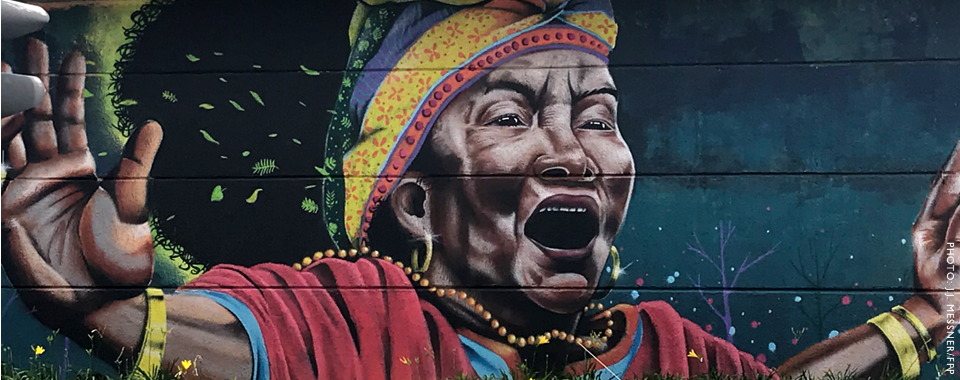BY CHARLES FIERTZ
Colombia saw its worst year-on-year change in the history of the Fragile States Index (FSI) in 2020, breaking a trend of almost uninterrupted improvement since the Index’s inauguration. The 2016 peace deal between Revolutionary Armed Forces of Colombia (FARC) and the Colombian government is looking increasingly fragile, with faith in the process failing amongst the government, the former rebels, and the Colombian public. Membership in armed groups has grown, coca cultivation has rebounded, and social leaders have been targeted in increasing numbers. While there were failures in the implementation of the peace deal under the preceding Santos administration, the deterioration of the agreement has accelerated under President Duque, who has been openly hostile towards it. The resulting erosion of the peace deal has been felt primarily in five provinces in Colombia’s north and southwest.
Since the beginning of the peace process, some former members of FARC, declaring themselves “dissidents,” abandoned the process and again took up arms. In December 2016, the month after the peace deal was signed, several key members of FARC’s former Eastern Bloc returned to their former territory in the eastern plains and the Amazon, which sits along key trafficking routes to Venezuela and Brazil, to rebuild their operation. Over the following years, increasing numbers of former FARC members left the peace process; by mid-2019, they numbered around 3,000 and had a presence in 18 of Colombia’s 32 departments. In August, Iván Márquez, FARC’s second-in-command, joined these “dissidents” and attempted to unify the former rebels under a single command. However these attempts were not successful – former FARC members exist in disparate groups that have largely abandoned their leftist ideology, becoming more akin to traditional organized crime groups. At the same time, the National Liberation Army (ELN), has taken advantage of FARC’s demobilization, the collapse of Venezuela, and the failure of the Colombian state, to increase their numbers from 1,400 members in 2017 to over 4,000 today, transforming into a hybrid Colombian-Venezuelan revolutionary army.

This growth of the armed groups has fueled, and has in turn been fueled by, increases in coca cultivation. Cultivation had fallen to a low in 2012-2013 according to UN figures, but it grew quickly in the following years, increasing by over 250 percent between 2013 and 2018, the last year for which there is data. Cocaine production followed a similar pattern, but more exaggerated, notably dropping off through 2013 and subsequently increasing more rapidly, hitting record highs. Cultivation has been concentrated, with nearly 80 percent located in the states of Nariño, Norte de Santander, Putumayo, Cauca, and Antioquia. The coca substitution program (PNIS), a key part of the peace agreement, was initially successful in slowing the increase after 2016 – nearly 100,000 families enrolled in the plan, which saw 94 percent compliance and just a 0.6 percent replanting rate. However, despite this initial success, as of 2019, nearly 90,000 families had yet to receive the full payment promised as part of the program, and over 40,000 had not received any payments. Furthermore, President Duque has cut back on even the limited support given to the program in favor of increased emphasis on forced eradication, despite this strategy having a 35 percent replanting rate.
The effort to help farmers move away from coca cultivation has sparked retaliatory violence, with armed groups vying to establish hegemony over the areas and revenue streams that FARC vacated when they demobilized. This violence has often targeted social leaders, such as union organizers, indigenous leaders, community activists, and human rights defenders. According to the Institute for Development and Peace Studies, nearly 900 such people were killed between the beginning of 2016 and September 2019. Most of these killings occurred in regions that FARC had controlled before the peace deal, where their demobilization left a security vacuum that the Colombian state failed to fill. The violence has been particularly acute in the same five provinces where coca cultivation is highest and, in 2019, also broadened to include the targeting of state representatives. For example, the leadup to the October municipal elections saw the highest rate of murdered politicians since 2015.
The Colombian peace process has always been fragile and the deal itself required two referendums to be approved. However, insufficient funding and distracted focus – on the part of both the Colombian government and the international community, who wanted to believe that the peace deal was the end of a process rather than the beginning of a new one – meant that the gains that were achieved were never institutionalized and sustained. The ascension of Duque, who has always been openly hostile to key elements of the peace deal, convinced many former FARC members that the government did not intend to honor the promises it had made. With the collapse of the Venezuelan state, and the subsequent rise of ungoverned spaces to organize outside of the control of state authority, an ocean of desperate potential recruits and record cocaine production offering windfall profits has filled the vacuum. In these lawless zones, thousands of former rebels have returned to the field, either as part of one of the FARC successor groups or the resurgent ELN.
While there is still time to rescue the peace process and curtail the revival of the armed groups that have plagued Colombia for decades, criminal entrepreneurship and violence is increasingly taking hold in several parts of the country. It will take a concerted effort by the government and its regional and international partners to return Colombia to the path of gradual improvement it was so recently on.
